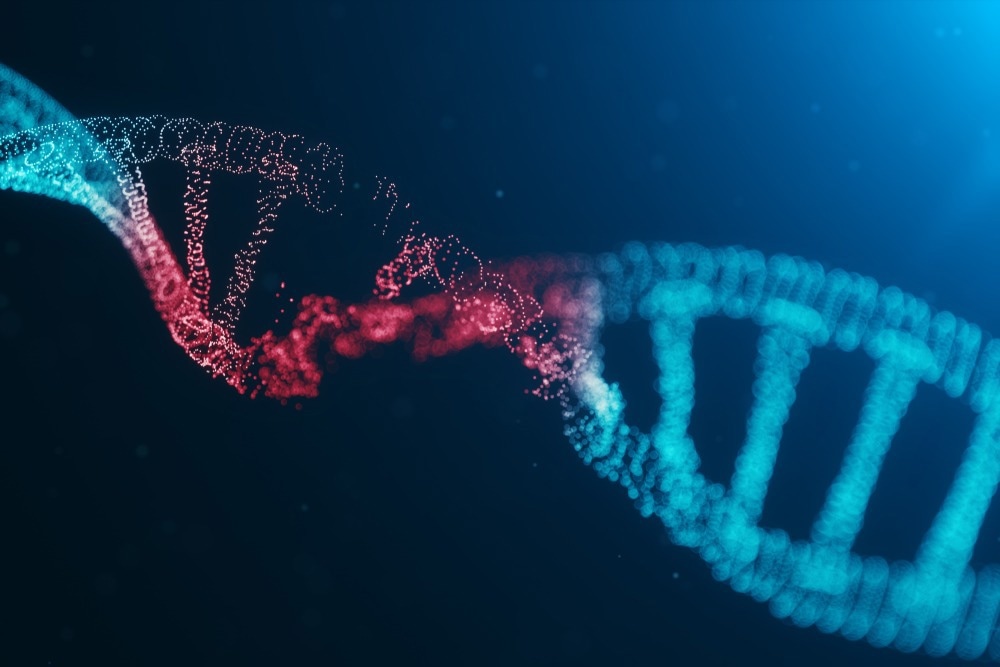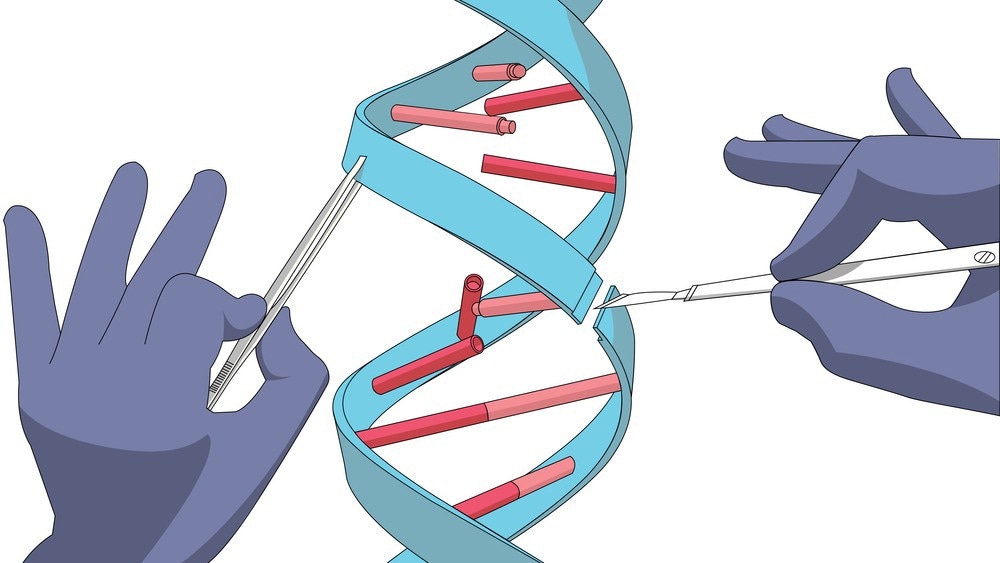In this article, AZoLifeSciences explores how DNA damage can occur and the mechanisms underpinning DNA repair.

Image Credit: Rost9/Shutterstock.com
What is DNA Damage?
DNA damage consists of a change or mutation that occurs to the sequence of bases and can be classified into two main subgroups, including endogenous and exogenous DNA damage. Endogenous and exogenous DNA damage can include mutations from oxidative reactions or reactive oxygen species, as well as environmental factors, respectively.
Types of Mutations
Chromosomal mutations are a type of mutation that include changes to the chromosome structure or number. This type of mutation can occur when a part of the chromosome breaks off and either rejoins incorrectly or does not rejoin at all, causing serious implications for the individual with the onset of diseases and disorders.
Gene mutations, which can also lead to diseases, can include changes to the nucleotide sequence of the DNA and have been summarized below.
Silent Mutations
Silent mutations are alterations in the DNA nucleotide base sequence that do not cause changes in the amino acid sequence. Due to the same protein being produced by the amino acid sequence, this type of mutation does not cause dysfunction.
Missense Mutations
Missense mutations include mutations that change one base pair in the DNA sequence, which leads to a different amino acid being coded for, producing a different protein.
Nonsense Mutations
Nonsense mutations can also cause an alteration of one base pair; however, in contrast to missense mutations, instead of substituting another amino acid, the mutation in the DNA sequence results in the cell stopping building the protein altogether. This results in a shortened protein that may be faulty, causing either improper function or no function at all.
Gene Duplications
Gene duplications or amplifications include abnormal repetition of a piece of DNA, which can lead to dysfunction in the resulting protein. An example of a developmental disorder that is caused by a gene duplication is Down Syndrome, which produces an extra copy of chromosome 21.
Insertion/Deletion Mutations
Insertion or deletion mutations include changes to the number of DNA bases within the gene, such as through the addition or deletion of bases. This type of mutation can include small changes with one or a few base pairs being added or deleted or can be larger changes such as entire genes or sections of chromosomes being added or deleted. This type of mutation can lead to a dysfunctional protein.
Frameshift Mutations
Frameshift mutations can be related to insertion, deletion and duplication mutations, with this mutation occurring when the addition or deletion of bases causes a change in the reading frame of the gene. The reading frame includes a triplet of bases being read to code for one amino acid, and changes to this reading frame can shift which bases are read within the triplet. This can result in different amino acid sequences, which typically produce a nonfunctional protein.

Image Credit: Perception7/Shutterstock.com
DNA Repair Mechanisms
DNA damage can cause cells to respond in different ways by activating the DNA damage response (DDR) pathways. DNA damage repair processes are critical for ensuring genetic stability is maintained and effectively remove most DNA errors that could result in mutations, impacting cellular processes such as metabolic processes and transcription.
There are approximately five main DNA repair pathways, including (i) base excision repair (BER), (ii) nucleotide excision repair (NER), (iii) mismatch repair, (iv) non-homologous end joining and (v) homologous recombination.
Excision Repair Mechanisms
Excision repair includes general repair of a wide range of chemical modifications that occur in the DNA, enabling damaged DNA to be recognized and removed. In BER, this consists of single damaged bases to be removed from the DNA sequence before being replaced by healthy bases complementary to the undamaged DNA strand.
Wide-spread DNA repair utilizes the NER mechanism to restore larger sections of damaged bases. This is an enzymatic pathway that recognizes and corrects a range of structural anomalies, including bulky lesions that distort the helix as well as non-helix-distorting lesions. Removing the damaged nucleotides involves dual incisions on either side of the lesion, which is then replaced by healthy, undamaged DNA.
DNA mismatch repair is used primarily for mismatched nucleotides, including insertion and deletion mutations that can occur during the DNA replication and recombination process. Correcting DNA mismatches in DNA replication ensures mutations are not present or made permanent in dividing cells.
Double-Stranded Break Repair
Double-stranded breaks in DNA include damage in both strands of the DNA through the entire chromosome, breaking into two pieces. This can occur due to some environmental factors, such as high-energy radiation.
Two main pathways are used to repair this type of DNA damage, including non-homologous end joining and homologous recombination.
In non-homologous end joining, the two broken ends of the chromosome are ‘glued’ together; this can be a challenging process and usually leads to a loss or addition of nucleotides at the break site. Due to the loss or addition of nucleotides, this repair mechanism results in a mutation.
In homologous recombination, a homologous chromosome that matches the damaged chromosome can be used to repair the break. This includes utilizing undamaged DNA as a template to repair and replace the damaged region of the broken chromosome. Homologous recombination does not typically result in mutations compared to non-homologous end joining.
Unrepairable DNA Damage
DNA damage and errors occur continuously in our cells, such as due to exposure to sunlight. However, they usually do not cause permanent damage or mutations due to critical repair mechanisms.
Still, when DNA damage cannot be repaired, a cell typically undergoes programmed cell death, known as apoptosis. This is significant as it ensures damaged cells do not divide and pass on faulty DNA to daughter cells.
When these mechanisms fail, and there are multiple mutations that occur in genes that accumulate in the same cell, it can result in cancer formation. This can occur when cells divide uncontrollably and cannot be repaired by the DNA damage response or controlled by typical cell regulation systems such as apoptosis.
Sources
Chatterjee N., et al. (2017) Mechanisms of DNA damage, repair, and mutagenesis. Environmental and Molecular Mutagenesis, 58(5). pp.235-263. doi.org/10.1002/em.22087.
Cooper, G. M. (2000) The Cell: A Molecular Approach. DNA Repair. 2nd edition. Available from: https://www.ncbi.nlm.nih.gov/books/NBK9900/.
Huang, R. & Zhou, P.-K. (2021) DNA damage repair: Historical perspectives, mechanistic pathways and clinical translation for targeted cancer therapy. Signal Transduction and Targeted Therapy. 6(1). doi.org/10.1038/s41392-021-00648-7.
Jakubowski, H., Flatt. P. (2023) 24.2: DNA mutations, damage, and repair. Biology LibreTexts. May 27, 2023.
Reardon, J.T. & Sancar, A. (2001) Excision repair. Encyclopedia of Genetics. Published online 2001. pp.673-675. doi.org/10.1006/rwgn.2001.0437.